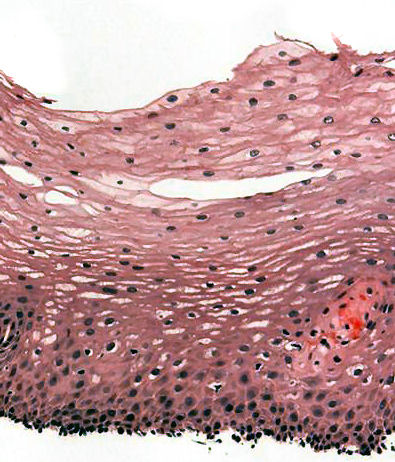WBR0806
Jump to navigation
Jump to search
| Author | [[PageAuthor::Yazan Daaboul, M.D. (Reviewed by Serge Korjian)]] |
|---|---|
| Exam Type | ExamType::USMLE Step 1 |
| Main Category | MainCategory::Histology |
| Sub Category | SubCategory::Gastrointestinal |
| Prompt | [[Prompt::A 57-year-old man presents to the physician's office complaining of excessive fatigue. Upon questioning, the patient reports that he is previously healthy, takes no medications, and has no allergies. On physical examination, the physician notes pale skin and conjunctivae. Laboratory work-up reveals anemia and low iron levels; the physician suspects gastrointestinal bleeding. Esophagogastoduodenoscopy (EGD) and colonoscopy are performed and random biopsies from various parts of the GI tract are chosen. The biopsy shown in the image below is representative of which part of the GI tract in this patient? |
| Answer A | AnswerA::Stomach |
| Answer A Explanation | AnswerAExp::The stomach is lined by gastric glands. |
| Answer B | AnswerB::Duodenum |
| Answer B Explanation | AnswerBExp::The duodenum is lined by villi and microvilli with the characteristic finding of Brunner glands. |
| Answer C | AnswerC::Ileum |
| Answer C Explanation | AnswerCExp::The ileum also contains villi and microvilli with the absence of Brunner glands. |
| Answer D | AnswerD::Colon |
| Answer D Explanation | AnswerDExp::The colon is characterized by the presence of crypts and goblet cells with the absence of villi. |
| Answer E | AnswerE::Esophagus |
| Answer E Explanation | AnswerEExp::The esophagus is characterized by the presence of nonkeratinized stratified squamous epithelium, as shown in the image above. |
| Right Answer | RightAnswer::E |
| Explanation | [[Explanation::Different parts of the GI tract are unique for the presence of different histological aspects that correspond with the function of every part. The histological appearance of esophagus is characterized by nonkeratinized stratified squamous epithelium as shown in the image above. In contrast, the stomach is lined by gastric glands. Generally, the duodenum, jejunum, and ileum have similar histological appearance but each has a unique features that differentiate them from each other. They contain villi and microvilli that increase the absorptive surface of the small intestine, crypts of Lieberkuhn, and plicae circulares. The hallmark of the duodenum is the presence of Brunner's glands. Finally, the colon contains crypts and abundant goblet cells but no villi. Educational Objective: The histological appearance of the esophagus is characterized by nonkeratinized stratified squamous epithelium. |
| Approved | Approved::Yes |
| Keyword | WBRKeyword::Stomach, WBRKeyword::Duodenum, WBRKeyword::Ileum, WBRKeyword::Colon, WBRKeyword::Jejunum, WBRKeyword::Epithelium, WBRKeyword::Villi, WBRKeyword::Biopsy, WBRKeyword::Brunner's glands, WBRKeyword::Microvilli |
| Linked Question | Linked:: |
| Order in Linked Questions | LinkedOrder:: |
